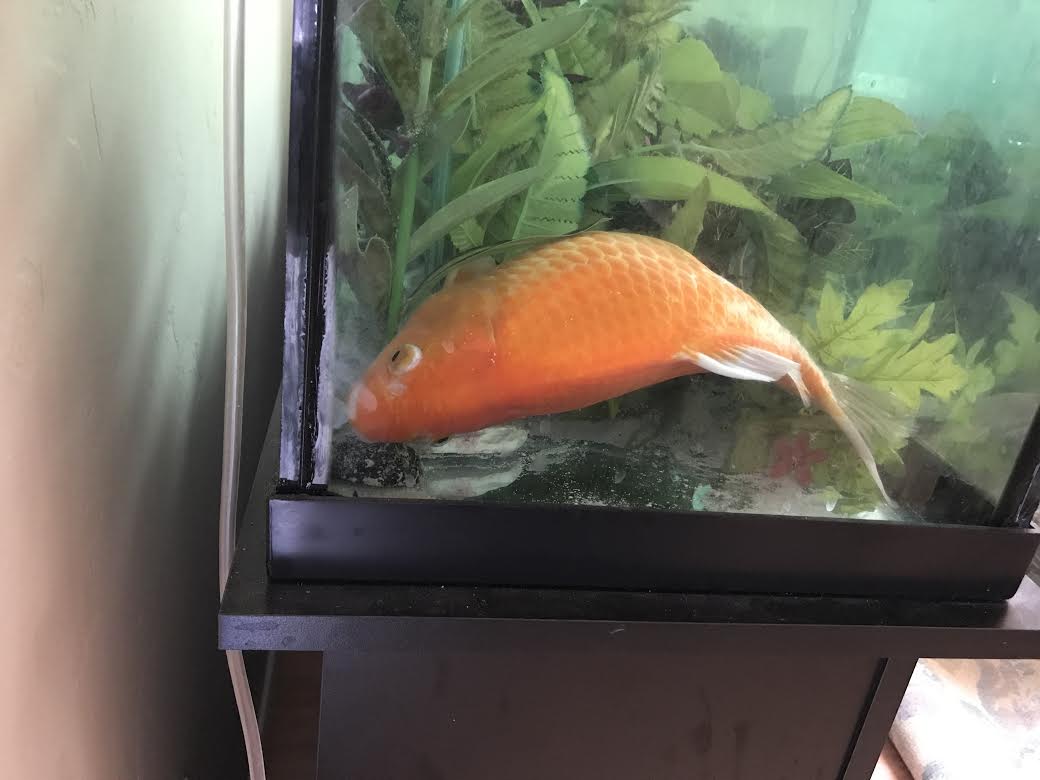NITRATE the gentle giant or monster
Symptoms: Bottom sitting; Loss of appetite; Pressed to bottom; Bent or Curled positioning; Crooked spine; Uncontrolled swimming; Swimming in circles; Spiraling; Spasms or twitching; Concave body
If your tank or pond is cycled, there are beneficial bacteria present. These friendly bugs are responsible for creating a safe environment for goldfish in the wild and in our goldfish house. The waste your fish create turns to ammonia; a deadly toxin. When ammonia is present, beneficial bacteria form; ammonia is their food source. They convert the ammonia to nitrite; friendly bug pooh. Nitrite invites a different species of beneficial bacteria; they convert the nitrite to nitrate
Goldfish bottom sitting
Nitrate the third and final toxin to convert is a toxin which goldfish can tolerate at low levels, unlike ammonia and nitrite. Some goldfish are more sensitive than others; perhaps having been poisoned in the past. These goldfish need to be kept at maximum levels of 12.5. Most goldfish can tolerate a consistent reading of 40, and some as high as 60 and showing no ill effects, although it isn’t advised. Levels above 20 ppm can and will poison them. Most goldfish don’t recover after experiencing extreme levels for long periods of time. Keep nitrate levels in your tank or pond from 10 to 20 ppm to keep fish safe
Nitrate the gentle giant
Closely related to nitrite, nitrates can be converted into nitrite in the digestive tract due to the presence of enzymes, but only in trace amounts. Nitrite is present in all of our blood. Increased levels dilate the blood vessels; which increases the blood pressure to dangerous levels. The presence of nitrite and nitrate in fish tank or pond water can create dangerous water conditions, but now we know nitrite in the blood can be the end result of nitrite or nitrate poisoning
Nitrite and nitrate both oxidize the iron atoms in hemoglobin, and reduces oxygen supply to the blood stream and tissue while simultaneously enlarging the blood vessels; this end result is called nitric oxide; which leads to septic shock
Nitrite and nitrate Fraternal Twins
Nitrates can only be eliminated from tank or pond water by means of a freshwater change or by water treatment that eliminates the toxin, but eliminating it with water treatment will not take the place of a freshwater change
Nitrates must be changed gradually. Many fish will be and have been affected by the toxin; some because levels were too high, but many more because levels were reduced to quickly
Nitrate the gentle giant
Goldfish curled
If you’re keeping your stocking levels at the site recommended percentage of 2.5 gallons of water per 1″ of goldfish body then 20% to 30% weekly changes should keep nitrates at a safe level
Test for nitrates frequently
If you have no friendly bugs; no beneficial bacteria, you’ll have no nitrites or nitrates in your water; just ammonia. Nitrite, the second toxin to be converted is closely related to nitrates; there must be friendly bugs in order for these two toxins to be present
Any reading of nitrite (the second toxin to covert) instead of nitrate, or the combination of the two indicates your cycle is out of balance; too few beneficial bacteria
If your stocking levels are double the maximum then you would have to exchange 20% to 30% of your tank or pond water twice a week in order to keep levels at a safe reading. If your stocking levels are half of the recommended amount then you would have to exchange 10% to 15% of your tank water weekly. Overstocked tanks and ponds require much more maintenance
If your nitrates readings are high compared to your stocking level; you’re over feeding. If they’re lower than average, you may be feeding too little. If nitrates are low, but your fish is bottom sitting, the condition may be unrelated to nitrates

Goldfish that require deep water may sometimes benefit from a salt or herbal bath can easily tolerate In house bath
Bent position
Learn more about bottom sitting
Nitrate the gentle giant
Goldfish that have been poisoned by nitrates develop extreme sensitivity to the toxin, tolerating it only at low levels
If nitrates are an ongoing problem in your tank or pond, check the nitrate levels in your tap water first and foremost; if this isn’t the case; consider some or all of the following options
1. Increase water changes; reduce stocking levels; test frequently
2. Encourage algae or plant growth; plants feed on nitrates keeping your tank or pond water safer, allowing you to change out less water; less frequently Algae the Living Plant
3. Reduce the amount of food being fed
4. Periodical use of water treatment that eliminates nitrates
If you are on a well; live in a rural area; have your nitrate levels checked yearly, for your goldfish’s safety and your family’s too. High nitrates are often found in farming communities due to the use of fertilizers
Study the 10 Steps to see if you’re providing the best care possible for your goldfish
Copyright 2008
Author: Brenda Rand